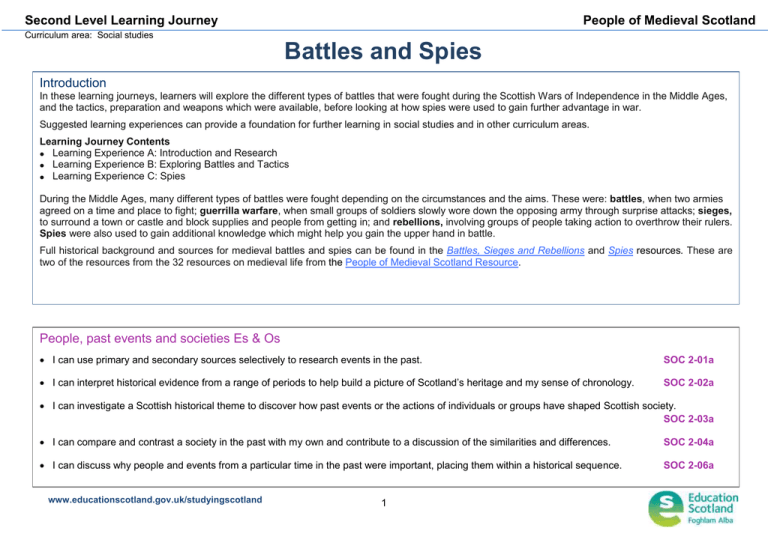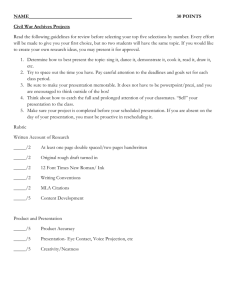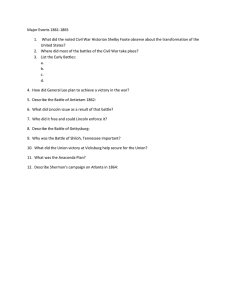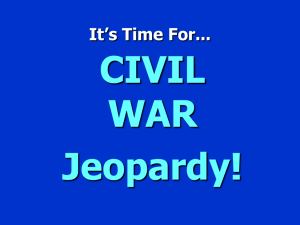Second Level Learning Journey People of Medieval Scotland Introduction
advertisement

Second Level Learning Journey People of Medieval Scotland Curriculum area: Social studies Battles and Spies Introduction In these learning journeys, learners will explore the different types of battles that were fought during the Scottish Wars of Independence in the Middle Ages, and the tactics, preparation and weapons which were available, before looking at how spies were used to gain further advantage in war. Suggested learning experiences can provide a foundation for further learning in social studies and in other curriculum areas. Learning Journey Contents Learning Experience A: Introduction and Research Learning Experience B: Exploring Battles and Tactics Learning Experience C: Spies During the Middle Ages, many different types of battles were fought depending on the circumstances and the aims. These were: battles, when two armies agreed on a time and place to fight; guerrilla warfare, when small groups of soldiers slowly wore down the opposing army through surprise attacks; sieges, to surround a town or castle and block supplies and people from getting in; and rebellions, involving groups of people taking action to overthrow their rulers. Spies were also used to gain additional knowledge which might help you gain the upper hand in battle. Full historical background and sources for medieval battles and spies can be found in the Battles, Sieges and Rebellions and Spies resources. These are two of the resources from the 32 resources on medieval life from the People of Medieval Scotland Resource. People, past events and societies Es & Os I can use primary and secondary sources selectively to research events in the past. SOC 2-01a I can interpret historical evidence from a range of periods to help build a picture of Scotland’s heritage and my sense of chronology. SOC 2-02a I can investigate a Scottish historical theme to discover how past events or the actions of individuals or groups have shaped Scottish society. SOC 2-03a I can compare and contrast a society in the past with my own and contribute to a discussion of the similarities and differences. SOC 2-04a I can discuss why people and events from a particular time in the past were important, placing them within a historical sequence. SOC 2-06a www.educationscotland.gov.uk/studyingscotland 1 Second Level Learning Journey People of Medieval Scotland Curriculum area: Social studies C Responsibility of All Es & Os: Prior Learning Learners would benefit from: First Level Using evidence to recreate the story of a place or individual of local historical interest. Comparing aspects of people’s daily lives in the past with my own by using historical evidence or the experience of recreating an historical setting. Literacy & English (Writing) Learners will have the opportunity to write a news report on battles. I consider the impact that layout and presentation will have and can combine lettering, graphics and other features to engage my reader. LIT 2-24a Interdisciplinary Opportunities Technologies Learners will have the opportunity to use electronic devices to research and present on medieval battles and spies. Throughout all my learning, I can use search facilities of electronic sources to access and retrieve information, recognising the importance this has in my place of learning, at home and in the workplace. TCH 2-03b www.educationscotland.gov.uk/studyingscotland 2 Second Level Learning Journey People of Medieval Scotland Curriculum area: Social studies Learning Experience A: Introduction and Research SAY Discuss different aspects of battles. Introduction The Scottish Wars of Independence saw several different battle techniques. These varied according to leaders and circumstances. Stimulus Wars take many different forms. What is a battle? What preparations must armies make before fighting? Possible evidence Possible learning opportunities / tasks Discuss in pairs or small groups the different types of battles (modern or medieval): o Why do people fight? o Who do they fight against? o How do they prepare for battle (people, location, weapons etc.)? o What tactics do they use? Homework Task: learners research a recent conflict to identify the elements discussed in class in a real-life example. Class discussion: what battles in history have they heard of? What information do they know already? What additional elements must they consider? MAKE/WRITE A display of the homework task to summarise class knowledge of modern warfare. DO Present to the class and peer assess their homework and the homework of others. Reflecting on learning Did learners explain the different types of battles and battle preparation clearly? Did learners plan out their discussion time effectively? Can learners identify good points and areas for improvements in other learners’ work? Have learners used ICT effectively? Useful resources Key learning Learners can: Present ideas clearly and listen to others, providing constructive feedback. Utilise ICT skills to investigate modern warfare and battles. Battles, Sieges and Rebellions resource at People of Medieval Scotland Look at newspapers / news on TV to see examples of current conflicts www.educationscotland.gov.uk/studyingscotland 3 Taking it further Use additional resources such as online newspapers (e.g. www.telegraph.co.uk or www.guardian.co.uk ) to investigate modern warfare. Learners could also access www.bbc.co.uk to research battles and wars. Learners can look beyond current daily news to explore the archived BBC information for analysis of wars. Second Level Learning Journey People of Medieval Scotland Curriculum area: Social studies Learning Experience B: Exploring Battles and Tactics Possible learning opportunities / tasks Introduction To understand the elements of a battle and its outcome, it is vital to explore the many aspects which come together during warfare. These include leadership and tactics, location and skills and especially weaponry. Stimulus How important are battle preparations for the eventual outcome? What must a leader take into consideration before starting to fight? Key learning Whole class discussion on the Battle of Bannockburn: look at leadership, aims, location, landscape, buildings, tactics, weaponry etc. Use this as an Introduction to group tasks. Divide into 5 groups, each taking a different battle/siege/rebellion from the Scottish Wars of Independence from the Battles, Sieges and Rebellions resource. o Alexander of Argyll’s rebellion, Andrew Murray’s rebellion, Battle of Stirling Bridge, Besieging Castles (Stirling and Elgin), Battle of Methven. Each group investigates their battle/siege/rebellion for: o Leadership, aims (why fight?), location and landscape, use of buildings, tactics, weaponry (e.g. swords, catapults, crossbows etc) Produce a wall display of battles around Scotland. Create PowerPoints and present their findings to the class. Create a report (written or verbal - filmed) for an evening news programme or newspaper to explain events and battle tactics. Possible evidence SAY Explain the different elements of their battle/siege/rebellion. WRITE News report on day/events of a battle/siege/rebellion. MAKE Model of the landscape of a battle/siege/rebellion. Reflecting on learning Did learners explain the different processes of various battles/sieges/rebellions clearly? Did learners plan out their discussion time effectively? Can learners identify good points and areas for improvements in other learners work? Have learners used their creative skills to demonstrate their thinking and ideas? Learners can: Handle a range of sources as evidence to present an informed view. Useful resources Think creatively and independently. Battles, Sieges and Rebellions, Castles and Weapons packages at People of Medieval Scotland www.educationscotland.gov.uk/studyingscotland Taking it further 4 Depending on school circumstances, pupils could plan a visit to their battle site/castle. Use additional web resources (such as www.historicscotland.gov.uk) for more information. Second Level Learning Journey People of Medieval Scotland Curriculum area: Social studies Learning Experience C: Spies Possible evidence Introduction In addition to the regular army, other people can have a key role in the outcome of a battle. Leaders can also use underhand tactics to gain an advantage which will help them be victorious. Stimulus What are spies? How do they operate? What can they contribute to a battle? How trustworthy are they? Is it morally acceptable to use these methods to win in wars? Key learning Learners can: Handle a range of sources as evidence to present an informed view. Apply their thinking to make reasoned evaluations. Possible learning opportunities / tasks In small groups, discuss what spies are, what they do, how they operate, how effective and reliable they are, and whether there are any moral dilemmas over using spies to help win a battle. Use fictional spies (e.g. Snape in Harry Potter, James Bond, Marvel Comics) to explore the identities and actions of spies. In the same groups as above, learners look at one experience each of a spy in the Scottish Wars of Independence and create a case study of a spy in action. o Drama of the spy’s actions or capture o Create a wall display of different types / experiences of spies. o Creative writing - learners use their knowledge of the above battles and spies to write a story of a spy and how they were used. SAY Explain how different spies were used in the Middle Ages. WRITE A piece of creative writing about an imaginary spy in the Middle Ages. DO Present their findings as a wall display on spying in the Scottish War of Independence. Reflecting on learning Did learners discuss and clearly convey the information they gathered on spies? Did learners plan out their discussion time effectively? Can learners identify good points and areas for improvements in other learners work? Useful resources Spies, Battles, Sieges and Rebellions, Castles and Weapons resources at People of Medieval Scotland A learning journey on Jean Valentine, a Second World War Code Breaker can be found in the Education Scotland Great Scots resource http://www.educationscotland.gov.uk/studyingscotl and/resourcesforlearning/scotlandintheworld/home coming/greatscots/valentine.asp www.educationscotland.gov.uk/studyingscotland 5 Have learners worked in partnership or in terms to communicate in different ways and settings? Taking it further Explore modern spies through websites such as www.nationalarchives.gov.uk/spies/ and explore spies, codes and ciphers and codemasters learners could create their own codes. Try www.mi5.gov.uk for information on how spies operate.






